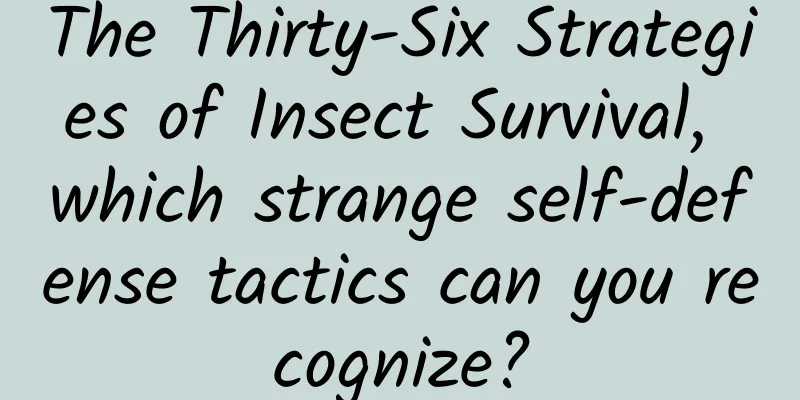The Thirty-Six Strategies of Insect Survival, which strange self-defense tactics can you recognize?

|
Insects are not only of many kinds, but also have various shapes and strange habits. In order to survive in the vast natural world, they must have various ways to protect themselves. Some insects have their own "weapons" to fight their enemies, while some insects are born without such "weapons", but they have adapted their body shape and color to the surrounding environment in the long process of evolution, relying on the cover of the environment to preserve themselves. Other insects have strong adaptability and excellent escape skills, and they can use various methods to protect themselves and survive. Next, let’s take a look at the “tactics” that bugs use to survive! By the way, I would like to remind you that there are high-definition insect pictures inside, so those who are afraid of insects should be careful! Mimicry Insects are members of the biological community in nature, which inevitably leads to various relationships between them and other creatures in nature. Mimicry is when an animal imitates the form of another animal , making itself look like them, thereby gaining the benefits of protecting itself and avoiding the invasion of natural enemies in daily life. Crowned butterfly on the sand in Tanzania, Africa (Photo source: Veer Gallery) The concept of mimicry is based on the idea that some species of insects are disgusting, unpalatable or inedible to birds and other predators, and that these species have striking colors to warn predators. Other harmless and tasty insects adopt similar patterns for protection , misleading predators into thinking they are unpalatable and staying away. But insects cannot survive by simply putting on camouflage. Take butterflies, for example. Only after some unpalatable butterflies are eaten can the rest of the butterflies survive . In addition, if a butterfly population contains a high proportion of delicious "disguisers", predators have a great chance of preying on them, and thus cannot quickly identify warning colors, thus losing their due conservation value. Chemical defense When some insects are disturbed or threatened by their natural enemies, they emit gases or odors to keep their natural enemies away, or they sting their natural enemies with poisonous stingers. Here are a few examples. 1. Carabids In an emergency, the carabid (walking beetle) can fire "cannonballs" from its anus continuously - a high-temperature liquid venom produced by the reaction of multiple chemicals such as hydrogen peroxide, quinones, and enzymes, which can blast powerful enemies to pieces. Perhaps people who love to play with insects have experienced its power, so they gave it a nickname, the fart beetle. Ground beetle (Photo source: Veer Gallery) 2. Wasp As the saying goes, "If you poke a hornet's nest, you will be stung." Hornets are famous for their stings. Even some unknown hornets have a strong instinct for self-defense and vigilance. If their survival interests are violated, the hornets on guard will immediately attack you. Being stung by a wasp seems to be bearable? But once stung by a wasp, you will be quickly besieged by a swarm of wasps. This is because when a wasp stings a person, the stinger and alarm pheromone will be left in the skin at the same time . The initial reaction after being stung is to hit the wasp. The smell of the pheromone is spread into the air by the waving action when hitting the wasp. When other wasps smell this smell, they are immediately in a state of anger and commotion, and can quickly and effectively organize an attack. wasp (Photo source: Veer Gallery) A unique way to save yourself In addition to mimicry and chemical defense, insects have other special methods, some of which "hurt the enemy a thousand times and hurt themselves eight hundred times", some "strike hard", and some simply "lie down and pretend to be dead". Let's take a look at these "advanced tactics" that are difficult to detect! 1. Avoid the important and focus on the trivial In order to escape the harm of the enemy, the crane mosquito will not hesitate to cut off its limbs to save its life. The legs of the crane mosquito are thin and long, which is very eye-catching. If it is caught or touched, it will easily fall off, and the insect itself will not be harmed, but it can take the opportunity to escape. In addition, in many species of butterflies, the eyespots are combined with structural features to form a "false head" at the inner corner of the hind wing . A small tail often extends from this part of the wing. When these butterflies are perched, the wings are closed and rubbed together, causing the tail to vibrate, as if the antennae of the head are moving. ** Most eyespots are considered to be defensive "target areas" that can attract predators such as birds to capture them.** Even if damaged, it will not endanger the life of the butterfly. Lycaenidae (Photo source: Fujian Daily) 2. Face the attack head on Termites, which damage large amounts of wood every year, have even stronger defense skills. Soldier termites have a pair of hard and sharp jaws (which can destroy lead!), which are powerful defensive weapons. They also secrete venom that sticks to the skin wounds of enemy insects, killing the injured enemy insects. Close up view of termites on dry leaves (Photo source: Veer Gallery) 3. Play dead and escape Have you ever seen a "dead" insect come back to life? That's the insect pretending to be dead. If you go to a wheat field, as long as you slightly touch the wheat leaves, sometimes even before you touch the wheat, the armyworm larvae or wheat leaf wasps that rest on the leaves will roll up and fall to the ground. If you go to a vegetable field, the same is true for beetles on the leaves. Before you catch them, they have already rolled into the heart of the vegetables. We call these phenomena the nature of suspended animation. Do insects really know that someone is going to catch them, so they pretend to be dead? Of course not, insects are not that smart! Insects' feigned death is actually a very simple stimulus response. When their eyes or sensory hairs on their bodies sense some changes in the surrounding environment, the nerves will send signals to cause the insect's muscles to contract. Once the insect's muscles contract, the legs that were originally resting on the plant will shrink, and its body will no longer be able to stop, so it will roll down by itself. If you don't believe it, you can pay attention to whether the insects pretending to be dead have their legs tightly folded. If they are really dead, most insects' legs are loose. This method can also be used to distinguish whether an insect is really dead or pretending to be dead. Weevil plays dead (Photo source: Veer Gallery) Conclusion In order to survive in this fiercely competitive nature, insects have used all their efforts to develop so many "tactics", and they are all very diverse and sophisticated. It is hard not to sigh that the survival of insects is really not easy! Editor: Guo Yaxin Produced by: Science Popularization China Author: Chongyan Chongyu Team Producer: China Science Expo |
>>: Extremely cold zone, how do these creatures survive in the Arctic?
Recommend
Sigh! Nearly 8 years after Jobs' death, Apple has lost another soul figure
Recently, Apple announced on its official website...
How can operations move from the extensive stage to the refined stage?
Last week I went to Didi and was invited to talk a...
Growth Hacker: Talking to Former Googlers about App Growth
The concept of growth has a long history in Silic...
When buying movie tickets, don’t fight for the last row.
I want to ask everyone, when you go to the cinema...
Xiaohongshu traffic trends in 2022!
In Xiaohongshu, I think identity types can be rou...
How to design a live broadcast room? Live broadcast room design guide!
Live streaming has long been the fastest and most...
How effective is information flow advertising? What are the advantages of information flow advertising?
What is information flow advertising ? "Feed...
With 20 billion views in 3 years, how does Ergeng impress users with its content?
As a content carrier that is suitable for use in ...
Rumor has it that 1haodian chairman Yu Gang and CEO Liu Junling have resigned
Rumors are often one step ahead of the truth. Ten...
Mason Investment Research · Super good track advanced practical video + text live broadcast group
Mason Investment Research·Super Good Track Advance...
What are the ways to promote Xiaohongshu?
When it comes to Xiaohongshu’s promotion methods,...
Xiao Weiqing: English Original Reading Basic Class | Shanghai International Studies University professor leads the reading of The Chronicles of Narnia
Xiao Weiqing: English Original Reading Basic Clas...
International Energy Agency: Natural Gas Analysis and Outlook 2022-2025
The report believes that from the demand side, af...
With dual cameras again, can Honor V8 lead the brand to charge into the high-end market?
When talking about Huawei and Honor, the word tha...
From getting started to giving up, an article reviews the history of Google tablets
After nine years of ups and downs, Google finally...









